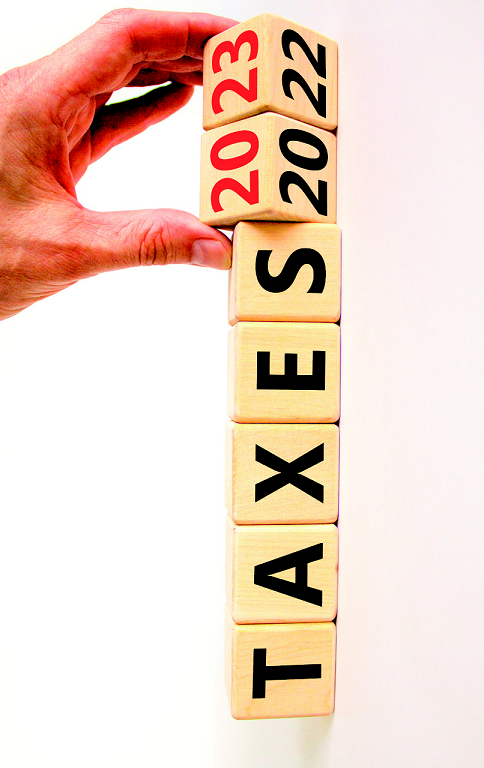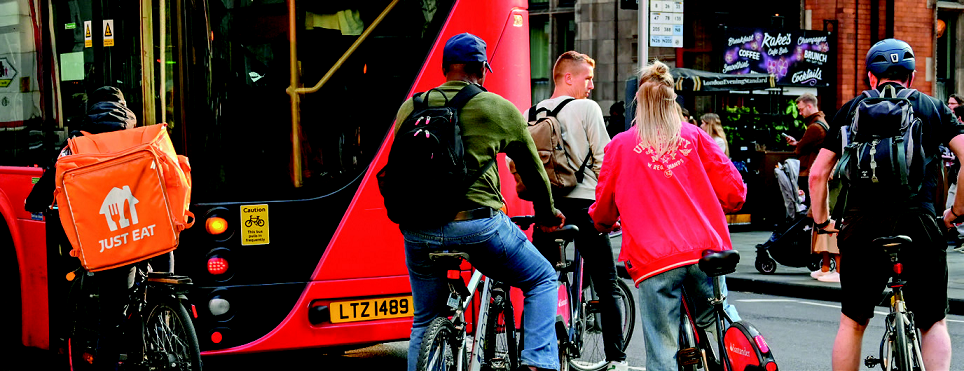Spring Newsletter 2023
Optional download pdf: Spring Newsletter 2023 →
Leading Article
Tax changes ahead
The new tax year starting in April will see personal allowances frozen, as well as cuts to tax exemptions that could increase your tax bills.
Your tax-free personal allowance will be frozen for the third year running at £12,570 and the basic rate band also held at £37,700. This means you will pay tax at the 40% rate when your total income exceeds £50,270. You can increase your higher rate threshold by making charitable donations under Gift Aid or paying pension contributions.
Rates and tax bands are different for Scottish taxpayers, who will see their higher rate tax (which kicks in when income exceeds £43,662) rise to 42% and top rate tax rise to 47%; the latter remains 45% for non-Scottish taxpayers. For all UK taxpayers, the top rate threshold is reducing from £150,000 to £125,140.
Dividends are taxed at 8.75% within your basic rate band, at 33.75% within the higher rate band and at 39.35% in the top rate band. Any dividends covered by your £2,000 dividend allowance are free of tax in 2022/23, but this allowance will be cut to £1,000 per person on 6 April 2023.
Capital gains are taxed at 10% within your basic rate band and 20% in the higher tax bands, although gains from residential property are taxed at 18% and 28% respectively. Capital gains that are covered by your annual exemption of £12,300 in 2022/23 are free of capital gains, but that exemption will be cut to £6,000 on 6 April 2023.
Tax rates for some companies are also increasing in April. All companies, outside the oil and gas sector, currently pay corporation tax at 19%, but this main rate will increase to 25% where profits reach £250,000. If your company’s profits don’t exceed £50,000 per year, it will still pay corporation tax at 19%. Between these limits, there is an effective marginal rate of tax of 26.5%.
These limits need to be adjusted where a company has ‘associated’ companies. We can help you decide which companies are associated for this rule.
This newsletter will outline various other tax changes of which you may need to be aware. Please contact us if you want to discuss any of the issues arising.
GENERAL
Addressing overdue tax bills
Many people are struggling to pay their bills right now, as tax is pushed down the list behind heating and food. If you still have tax outstanding for 2021/22, there are some things you can do.
Firstly, review your payments on account for 2022/23, which are scheduled to be paid in two equal amounts on 31 January 2023 and 31 July 2023. If your profits from your accounts ending in 2022/23 are likely to be lower than in the previous accounts, you will owe less tax for 2022/23 than 2021/22, so you need to apply to reduce the payments on account. We can help you with this.
Secondly, where you made a lower profit than expected (or a loss) for 2021/22, you may be due a tax repayment. This will be set-off against the tax shown as payable by 31 January 2023. However, that sum will include the first payment on account for 2022/23, which you can elect to reduce.
If you have funds coming in that will enable you to pay off your tax bill in chunks, you should apply to HMRC for a “Time to Pay” arrangement. This can be done online, where the outstanding tax does not exceed £30,000 and you have no other tax debts. In other cases, we can help you negotiate a payment plan with HMRC.
Penalties of 5% of the late paid tax can be charged where the final tax payment for the year (“balancing payment”) is more than 30 days late, in addition to interest that is currently charged at 6.5%.
HMRC chases gig economy workers
HMRC is writing to online sellers, gig economy workers and influencers, asking for tax to be paid up for earlier years.
People who make money from the online content they create may not realise that they need to declare that income for tax purposes, where it exceeds £1,000 per year. This rule applies even if there is no tax to pay because the individual’s total annual income is less than their tax free personal allowance (£12,570).
Individuals who sell goods, or their own services, through an online marketplace also need to declare this income to HMRC where it exceeds £1,000 per year. This will include people who sell items on Ebay or Etsy, as well as Uber drivers and self-employed deliverers.
HMRC say that the letters are only being sent where it has information that the recipient has earned more than £12,570 from the online sales, such that tax may be due.
If you get such a letter, don’t assume that further tax is payable. The income reported to HMRC by the online marketplaces will be amounts of gross sales. You may have deductible expenses to set against that sales income, meaning that the net profit figure is much smaller.
The HMRC letter also asks the recipient to make a disclosure using the online digital disclosure service (DDS) facility and return a certificate of tax position within 30 days. Note, however, that there is no legal obligation to complete a certificate of tax position. Also, the declaration on the certificate is not limited to a particular tax year, so you may be asserting your tax affairs for every earlier year are totally correct, and this may not be the case.
However, you should reply to HMRC within the deadline given, indicating how you will provide the information required. We can help you with this.
We can also advise you on the best course of action where there is income to disclose for earlier years.
Dealing with PAYE K codes
A PAYE K code reduces your personal allowance to zero and adds a notional amount of income on to your salary to be taxed. The imposition of a K code will result in a significant amount of tax being deducted from your earnings.
HMRC will impose a K code to collect existing tax debts, tax underpayments that it calculates will arise, and tax penalties imposed for late returns or late payments.
If you run your own company, you may have taken a significant dividend in 2021/22, as we knew the tax on dividends was going to increase on 6 April 2022.
HMRC may have assumed that the same pattern of large dividends would continue into 2022/23 and coded this high level of untaxed income into your tax code. This could result in a K code for 2022/23 or 2023/24.
If you have taken a more modest level of dividends in this tax year, your PAYE code won’t reflect your current income.
To remove the K code, you need to inform HMRC of your current level of expected dividends. You can do this through your online personal tax account under the PAYE heading, or by calling HMRC. We recommend you access your online personal tax account at: www.gov.uk/personal-tax-account , where you can find a lot of useful information about your tax payments and liabilities.
Unfortunately, HMRC has not given tax agents access to personal tax accounts, so we can’t make the online adjustment to your tax code, but we can show you what to do.
Where a K code has been imposed to collect a tax debt you had no knowledge of, because you haven’t received letters about it, we can challenge the amount of tax due.
Please tell us as soon as you receive a PAYE K code.
Taking your profits as dividends
If you are a company owner, you will be used to taking funds you need from your company in the form of a small salary, with anything extra paid as dividends, or perhaps as rent or interest.
For some years the first £2,000 of dividends received by each taxpayer has been tax-free, but that is about to change. From 6 April 2023 only the first £1,000 of dividends received by each taxpayer in a year will be tax-free and from 6 April 2024 that dividend allowance will be cut to £500 per year.
Where your family company pays dividends to shareholders (such as family members), up to their dividend allowance, you need to review this strategy for 2023/24. We can help you with this.
Taxpayers who receive dividends in excess of their dividend allowance need to inform HMRC and complete a tax return to declare that unearned income and pay the tax due.
The taxable dividend income is treated as falling into the taxpayer’s highest tax band where it is taxed at these rates in 2022/23:
- Basic rate band: 8.75%
- Higher rate band: 33.75%
- Top rate band: 39.35%
The dividend tax rates were increased on 6 April 2022; unless changed again in the Budget on 15 March 2023, they will be the same in 2023/24.
Paying up your NICs
If you haven’t already retired, you need to rack up 35 full years of National Insurance Contributions (NICs) in order to receive the maximum state retirement pension. To receive any amount of state retirement pension, you need at least 10 full years of NICs contributions.
Your online personal tax account (at: www.gov.uk/personal-tax-account) will show you how many full years of NICs you have and also where there are gaps in your NICs record throughout your lifetime.
These gaps can arise where you haven’t worked for a period, such as when studying, or caring for children. In many cases a break in work should be automatically filled with NIC credits, but in some circumstances (e.g. when acting as foster carer or a grandparent caring for a child), you may need to apply for class 3 NICs credits.
Where you have a gap in your NICs record, you can normally go back up to six years and pay voluntary contributions to fill in the missing weeks, thus making a tax year complete for NICs. Note that only complete NICs years count towards your state pension. You therefore have until 5 April 2023 to make up gaps in the tax year 2016/17.
However, currently there is a special dispensation that allows women aged under 70 and men aged under 72 to complete gaps in their NICs record right back to 6 April 2006. This opportunity to make up these old years with voluntary NIC payments closes on 5 April 2023, so there is not much time to take action!
We can help you calculate whether it is worthwhile filling gaps in your NICs record.
Separation to become less taxing
The government is planning to change the CGT rules for separating spouses. Currently, transfers can be made between couples on a tax neutral basis only up until the end of the tax year of separation (not divorce). This is a tight deadline! Inter-spousal transfers after this deadline may trigger a CGT charge.
The new rules will extend the deadline to three years from the end of the tax year of separation, giving much greater time for couples to sort out their affairs without worrying about tax arising. The new rules will apply for transfers on or after 6 April 2023, irrespective of the date of separation. Also, transfers as part of a formal divorce settlement will always now be tax neutral from that date.
Other proposed changes cover situations where:
- a departing spouse retains an interest in the family home; or
- one spouse transfers their share of the matrimonial home to the other on divorce, but they retain a right to a share of the proceeds when the property is eventually sold.
Please talk to us as soon as possible if you are going through a separation or divorce, so that we can help you avoid nasty tax shocks.
PROPERTY
Relief for excess mortgage interest
Since 2020/21, the deduction of mortgage interest and other finance costs (e.g. arrangement fees) from residential rents is completely blocked for tax purposes for individual landlords (not companies). Instead, the landlord receives tax relief at the basic rate (20%) as a tax credit against the tax due on the property income.
With interest rates rising, as well as the cost of repairs, the amount of interest paid in a year may be greater than the net profit from the property. This is how you get tax relief for that excess interest.
The amount of tax credit is calculated as 20% of the lowest of:
- finance costs for the year, plus any unused interest brought forward from an earlier year;
- property profits for the year, before finance costs;
- landlord’s total income (ignoring any savings or dividend income) that exceeds the Personal Allowance of £12,570.
If the expenditure on the property business (excluding interest) is greater than the income, meaning a loss has been made, all of the interest is carried forward to the next tax year. There is no limit on how many years the unrelieved finance costs can be carried forward. The property loss is also carried forward to be used against the next available profits from the property letting business.
Example
Bob, a builder, has rental profits in 2022/23 of £16,500 before paying interest of £6,000. In the previous year, due to a large amount of repairs work, he made a loss of £1,500 from his property business and couldn’t relieve the interest of £4,000 paid in that year. His trading profits from his building business are £40,000.
Bob’s tax credit is calculated as 20% of the lowest of:
- Finance costs = £10,000 (4,000 + 6,000)
- Property profits = £15,000 (16,500 - 1,500)
- Total income = £42,430 (40,000 + 15,000 - 12,570)
His tax credit is £10,000 x 20% = £2,000.
Be sure to record the amount of interest paid in each tax year that relates to your let properties.
Realise those capital losses
If you are planning to sell any property or your business in the near future, be aware that the annual exemption for capital gains tax will be cut from £12,300 to £6,000 on 6 April 2023. That exemption will reduce again on 6 April 2024 to £3,000, so long-term planning is needed where gains are expected to be made.
Where you have made capital losses in the past, those can be very useful, as the loss from an earlier year is set off against gains before deduction of the annual exemption.
Capital losses are automatically carried forward to be used against gains in a future year, but the loss must be claimed on the tax return first. To be eligible to be carried forward, a capital loss must be claimed within four years of the end of the tax year in which it arose, so by 5 April 2023 for losses that arose in 2018/19.
You may have potential capital losses from holding cryptocurrencies, following the crypto market crash in November 2022, or hold other assets that now have little or no value.
If the assets (e.g. shares) still exist, you may wish to make a ‘negligible value’ claim to create a capital loss.
We can help you claim your capital losses or make negligible value claims.

EMPLOYEE
National Minimum Wage rises
The annual increase in the National Minimum Wage (NMW) rates are linked to the rate of inflation, which for the past few months has been hovering around 10%. Hence the NMW rates that must be paid for pay periods starting on and after 1 April 2023 have all risen by around 10%.
| Age | Hourly Rate 1 April 2023 |
|---|---|
| 23 and above | £10.42 |
| 21 to 22 | £10.18 |
| 18 to 20 | £7.49 |
| Under 18 | £5.28 |
| Apprentice | £5.28 |
The rate for those aged 23 and above is known as the National Living Wage.
In addition, the daily accommodation offset will rise from £8.70 to £9.10. This is the maximum amount the employer is permitted to ignore as a deduction made to charge the worker for living accommodation provided. If the employer deducts more than this amount from the worker’s wages, the excess is treated as reducing the amount of earnings for NMW rate purposes.
No other deductions from wages are permitted to be ignored for NMW rates. Employers often deduct small sums for uniform, food, childcare vouchers or even for places at the child nurseries where the employee works. All of these sums must be taken into account when calculating the net wage (before tax) which HMRC checks against the relevant NMW rate.
Please talk to us before setting up any form of salary substitution, so that we can check that the NMW rules are not being broken
Student loan repayments
All sorts of people can be liable to repay a student loan to the Student Loan Company, including those who are drawing a pension, are self-employed or a landlord.
Student loan repayments (SLRs) are normally deducted from salary by employers under PAYE, so many people assume that SLRs are not due on rental income or pensions. This is not correct!
There is also the odd twist that SLRs will only be due from rental or pension income if the taxpayer needs to file a self assessment tax return and the taxpayer’s ‘unearned income’ exceeds £2,000 for the year.
Unearned income includes:
- profits from letting (after deducting £1,000 property allowance, where appropriate);
- profits from trading (after deducting £1,000 trading allowance, where appropriate);
- pension income.
The £2,000 of unearned income is an ‘all or nothing’ threshold. Once that unearned income exceeds £2,000, the whole amount is subject to SLR, deducted at 9% (or 6% for post-graduate loans).
Example 1
Susan earns £20,000 per year and has a Plan 1 student loan, for which the repayment threshold is £20,195 for 2022/23. She is therefore not liable to make SLRs on her earnings.
However, Susan also has a let property, which generated profit after expenses of £2,400 in 2022/23. She needs to register for self-assessment to report her property income and expenses. On submission of her tax return, Susan will be liable to pay SLR at 9% on rental profits of £2,205 (20,000 + 2,400 – 20,195) as her total property income profits exceed £2,000. This SLR (£198.45) will be payable by 31 January 2024.
Example 2
Leslie has a Plan 2 student loan, which has a repayment threshold of £27,295 for 2022/23. He has salary of £27,000, which is under the SLR threshold, so no SLRs are deducted. He also draws a pension of £4,000, taxed under PAYE, but which is not subject to the SLR at source.
However, Leslie makes £2,500 profit from a small trade, after deducting the trading allowance of £1,000. This means he needs to register as self-employed and complete a tax return, to report that trading income.
As Leslie’s total unearned income reported on his tax returned is £6,500 (2,500 + £4000) he will have to pay a SLR at 9% on £6,205 (27,000 + 6,500 -27,295), i.e. £558.45.
We can help you calculate your SLR liability, to avoid any nasty surprises.

BUSINESS
MTD for income tax is delayed again
Sole traders and individual landlords have an additional two years to prepare for the new reporting requirements under Making Tax Digital for Income Tax Self-Assessment (MTD ITSA), which is now due to come into effect from 6 April 2026.
Those with small levels of sales have even longer to prepare, as the turnover threshold for entering the MTD ITSA regime for sole traders and individual landlords will be set at £50,000. This turnover threshold will be reduced to £30,000 from 6 April 2027.
The government has said it will commence a review into how the MTD ITSA service can be shaped to meet the needs of smaller businesses and to look at the best way for them to fulfil their Income Tax obligations. Only when that review is complete, and after consultation with businesses, tax agents and others, will the government set out plans for any further mandating of MTD ITSA beyond 2027.
No date has been set for the expansion of MTD ITSA to partnerships of any type. The expansion of MTD to corporation tax now seems to be a very distant ambition.
However, there is some bad news - all unincorporated businesses, including partnerships, will be forced to report profits on the tax year basis from April 2024. Around one third of businesses that are affected by the shift to the tax year basis are partnerships. Limited liability partnerships (LLPs) are similarly affected.
If your business uses an accounting period which does not end from 31 March to 5 April, there will be some complicated calculations to undertake for 2023/24. We can help you with this.

New VAT late payment penalties
The old system of VAT default surcharges could be quite harsh, as a penalty of up to 15% of the late paid VAT could be levied for paying just one day late.
The new system, that applies for VAT periods beginning on or after 1 January 2023, is fairer to those who miss the VAT payment deadline by a few days.
You will have up to 15 days to pay your VAT, or arrange a “Time to Pay” agreement, without incurring a penalty. In 2023, this 15-day grace period is extended to 30 days.
At day 30, a penalty will be charged at 2% of the unpaid VAT at that time. From day 31 another penalty is charged daily, based on an annual rate of 4% of any outstanding VAT due.
In addition to the penalty for paying late, interest is charged on any late payment at (currently) 6.5% p.a. If you are due a VAT repayment that HMRC does not pay on time, you will receive repayment interest at 3% at the moment.
There is no carry forward of default periods or surcharge levels from the old VAT penalty system into the new regime, which is very good news!
New VAT late filing penalties
Now that all VAT registered traders must submit their VAT returns using MTD compatible software (unless they have been granted an exemption), HMRC has introduced a new penalty regime to punish late filing.
For VAT periods beginning on or after 1 January 2023, a point is awarded for each late VAT return. A £200 penalty is levied only when the appropriate points threshold is reached, which depends on how regularly the return is filed:
- Quarterly returns: 4 points
- Monthly returns: 5 points
- Annual returns: 2 points
Taxpayers who file quarterly VAT returns will receive a £200 penalty when they submit the fourth VAT return late. Each subsequent late form will trigger another £200 late penalty, until the points slate is wiped clean by a period of perfect compliance.
Perfect compliance means being up to date with all outstanding VAT returns and filing current VAT returns on time for 12 months (6 months for monthly returns, 2 years for annual returns).
Where you have been in the habit of submitting your VAT return late, you won’t have suffered a penalty if there was no VAT to pay.
You won’t get away with this under the new points and penalties system, as points are awarded for late returns whether there is any VAT to pay or not.
This newsletter is written for the benefit of our clients. Further Advice should be obtained before any action is taken.



